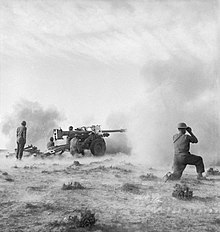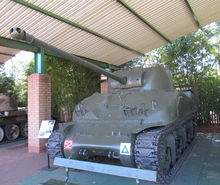17 Pounder Gun 💥💥with crew by Airfix




Before the QF 6-pounder had entered service, the British predicted that it would soon be inadequate given the increasing armour of German tanks. In late 1940, the design of a replacement began, and was largely completed by the end of 1941. A prototype production line was set up in spring 1942, and with the appearance of Tiger I tanks in early 1943 in the North African Campaign, the first 100 prototype 17-pounder anti-tank guns were quickly sent to help counter this new threat. So great was the rush that they were sent before proper carriages had been developed, and the guns had to be mounted in the carriages of 25-pounder gun-howitzers. These early weapons were known as 17/25-pounders and given the codename Pheasant. They first saw action in February 1943.
Fully developed 17-pounders started production in 1943 and were first used during the Italian Campaign. They became one of the most effective weapons on the battlefield, on both carriages and tanks.
The 17-pounder anti-tank guns also saw action in Korea against tanks and in general support use against bunker positions. After Korea, the gun was largely replaced in the tank role by the 84mm calibre, Ordnance QF 20 pounder, and in the anti-tank role by the BAT, MOBAT and 120 mm L6 WOMBAT series of recoilless rifles.

The 17-pounder outperformed all other Allied armour-piercing guns, and was quickly adapted for use on various tank chassis. However, few tanks were capable of carrying such a large gun due to the size limitations of their turret rings. A new British tank specification, A29, was produced to meet the need for a 17-pounder armed cruiser tank. While the A29 was eventually cancelled without a successful design being produced, an amended specification, A30, reached production in 1943. The A30 specification reduced weight and enabled the use of Cromwell tank components as a design expedient. The resulting Cruiser Mark VIII Challenger had a longer hull and provided a larger turret, allowing the 17-pounder to be mounted along with space for a second loader, thought to be required for the gun's larger ammunition. However, production of the tank took time and few could be completed before the allied invasion of Normandy.
While developing the Challenger tank, the British devised a conversion for their US-supplied M4 Sherman tanks to mount the 17-pounder. This was applied in sufficient numbers to put them into service in time for D-Day as the Sherman Firefly. The gun was a modified design that was produced specifically for the Firefly. The breech of the gun was rotated 90 degrees to fit inside of the height of the turret, i.e. it lay on its side. An additional box was welded to the back of the turret to take the radio, which was moved to allow for the breech and its recoil.[note 2] Additionally, a new recoil mechanism, based on that of the 6-pounder was developed to further shorten the recoil, while also shortening the gun cradle.[3]Production of the Challenger was cancelled, and more Shermans were converted until about 50% of Shermans in British service were Fireflies.

The British also converted some of their US-produced M10 tank destroyers, replacing the 3-inch (76 mm) gun with the 17-pounder; the resulting vehicles were called 17pdr SP Achillesor just 17-pdr M10C. These served with Royal Artillery as self-propelled guns.
The 17-pounder was also successfully trialled on the Australian-designed Sentinel tank, though no Sentinels equipped with this gun entered service with the Australian Army.
A variant of the 17-pounder, the 77mm HV, was used on the Comet tank. A separate weapon, this fired 17-pounder projectiles in a more tank-compatible form, and ultimately replaced the need for 17-pounder tanks late in the war.
As the war came to a close, the 17-pounder was also deployed on the Centurion tank, until ultimately being replaced by the 20-pounder.
The United States Army did not use the 17-pounder, though the gun was offered to US forces with a number of Sherman tanks modified for testing.[4] US tanks began to use the 76 mm gun M1 instead.























/http%3A%2F%2Fstorage.canalblog.com%2F96%2F00%2F1123093%2F134247667_o.jpeg)
/http%3A%2F%2Fstorage.canalblog.com%2F06%2F82%2F1123093%2F134235267_o.jpeg)
/http%3A%2F%2Fstorage.canalblog.com%2F63%2F65%2F1123093%2F134214755_o.jpeg)
/http%3A%2F%2Fstorage.canalblog.com%2F80%2F34%2F1123093%2F134214751_o.jpeg)